As a result of writing about Saraguay at this website, I now have a much better understanding of the central role which the British empire played during a previous era in the history of Montreal
Update: On Jan. 23, 2024, Klaas Vander Baaren mentioned by email that it wasn’t just Montreal Canadiens players who played golf at Marlborough; in an email (which Klaas has given me permission to post) he wrote:
It wasn’t only the Canadians hockey players who played at Marlborough G&CC. I caddied for Milt Schmidt, coach of the Boston Bruins, among others. The club welcomed all NHL folks and most of them used caddies.
This is really interesting to know. Such details about the course are of tremendous value.
*
In a previous post, I’ve shared comments of interest from Bruce Miller and Klaas Vander Baaren concerning an aerial photo of the Marlborough Golf and Country Club.
The photo was taken at some point close to when the club was rebranded as the Cartierville Golf and Country Club, before it was finally closed in the late 1960s.
If any reader is able to find articles from past issues of The Montreal Star or The Montreal Gazette describing the closing of the course, and the reasons leading up to it, please let me know.
It would be great to post such information at this site in future.
I’ve accessed online versions of these newspapers in years past but my attention these days tends to be on other forms of research about other topics.
Same goes for aerial photos of the course from earlier decades. If any reader is able to locate such photos, please let me know. Again, it would be great if we can post such additional aerial views to this site.
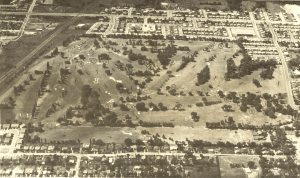
Click on photo to view locations of the greens. Photo source: Alain Chaput. Click on photo to enlarge it.
Bob Carswell’s comments about the aerial photo that Alain Chaput has shared
Bob Carswell. meanwhile, has shared the following comments about the one aerial photo – a great photo shared with us by Alain Chaput – that we have available at this time. He writes:
Understand first of all that my connection with the golf course goes back to my early years in Montreal. We moved to Cartierville because most of my extended family lived along the north shore of the island. Cartierville was home to my surrogate Grandparents as all of them [Bob’s Grandparents] died between 1926 and 1949.
My surrogate Grandparents lived backing onto the eighth green of the Marlborough Golf Course. My oldest uncle and his family lived on Somerset Road with his backyard connecting to the seventh fairway, I think it was, in the St. Laurent part of Somerset Road.
So, as you can see, I had a family connection of sorts to the club. At a very young age, seven or eight, I also began to caddy there for $2 per 18-holes, money I appreciated.
I remember caddying one time for Elmer Lach who during his rugged lifetime in the NHL had broken his nose 7 times and had a fractured skull. He played for Montreal from 1940 to 1954. Born in Saskatchewan, he lived to be 97 years old dying in Kirkland, PQ, in 2015. We should all live that long.
I was nine years old in the summer of 1954 and was one of the last to leave the old Caddyshack which had been moved from the front of the pro shop because the kids all left such a mess there and they wanted to clean up the image of the pro shop’s front yard, so to speak.
As I walked my bike across the 9th fairway, it started to rain with vengeance. The approaching thunder encouraged me to stop at the Mitchell house on Golf Road. While I was there, drying off, there was a party going on and I watched a couple of trees being severed off by a bolt of lightning. It certainly gave you an indication of the potential force of the storm we came to know as Hurricane Hazel.
Fortunately, the house withstood the damage and I often thought since then, that I could have been killed if the house had been brought down but at the age I was, the house was a safe haven. I do not know what damage it did to the golf course but I am sure some trees came down.
When the storm had passed, I got on my bike and began my trip home. The Saraguay estates were lined with giant oak trees so I was surprised at what I found. As I approached the estate start of the village marked by those trees, I found a city crew in the process of removing a number of those trees to clear the way for traffic. As I climbed over some of them, I counted a total of 14 giant oak trees that were brought down. The trip home to Martin Avenue was of no consequence from there.
Now 70 years later with a photographic memory, I still remember the events of that day like it was yesterday.
Click here for previous posts about Hurricane Hazel >
A feature of the geography of Saraguay was the presence of summer estates belonging to owners who in a previous era had established a strong business presence in Montreal. The impressive polo grounds in Saraguay, discussed in previous posts, were connected with the estates.
Click here for previous posts about Saraguay >
Canadian Golfer magazine
I’ve found it of interest to read about the designer of the Marlborough Golf Course – and to read past issues of Canadian Golfer magazine.
I found it of interest to learn, in the course of an online search, that Golf Course architect Stanley Thompson (1893-1953) designed the Marlborough Golf and Country Club.
The website of the Stanley Thompson Society describes Stanley Thompson’s connection as follows: “Designed by Stanley Thompson in 1923 as an 18 hole championship course and a 9 hole ‘ladies and beginners’ course, the course opened in 1924. The course no longer exists.”
I’ve also come across Canadian Golfer magazine, which includes references to the Marlborough course in some of its issues:
Click here to browse past issues of Canadian Golfer >
I have posted advertisements from past issues of the Canadian Golfer.
One of the ads is for a businessman named Red MacKenzie, based at the Marlborough Golf Club, who was advertising his products and services.
I have also posted ads for golf clothing. As well, I found the automobile ad from the Ford Motor Company of interest.
Click here for a previous post about the legacy of Henry Ford >
The ads for beverages in the Canadian Golfer underline that golf was considered a pastime associated with aristocrats and sophisticated people who had a little money to spend. Some of the ads which I’ve posted feature illustrations from an era in which such works of art were a key feature of advertising. I much enjoy viewing such illustrations. In years past they served as a great way to tell a (remunerative) story; a great way, years ago, to sell a product.
The ad for pipe tobacco underlines that in decades gone by, smoking was widely promoted as associated with an aristocratic lifestyle – associated with the rarified lifestyle of the upper reaches of the British aristocracy.
Click here for previous posts about British empire >
Great ad for portable Remington typewriter
I enjoyed coming across the ad for a Remington portable manual typewriter. From 1975 until 1980, until it dawned on me that I could make more money writing report cards in my role as a public school teacher, I worked as a freelance writer.
In those years I did my work interviewing people by phone or in person. Then I would write out a draft of an article with pen (or pencil) and paper. Finally, I would sit down and start typing at my Olympia portable typewriter, which I had bought at a typewriter shop – now long gone – in downtown Toronto.
A feature of writing in those days was that after literally cutting and rearranging a typewritten draft of an article, using scissors and Scotch tape, you finally had to sit down and retype the whole article.
Subsequently I realized that, with a desktop computer, you could do all the cutting and pasting sitting at a computer monitor – and then, amazingly enough, when you were all done with editing the article, all you had to do was to print out the final version. You would just press a key on the keyboard and the job was done. Amazing! No retyping was required. That made a huge difference.
That said, I enjoyed the Olympia typewriter and used it for many years before it was totally worn out from hundreds of hours of pounding on the keys.
Tobacco industry; professional hockey (and many other team sports, amateur and professional); oil and gas industry
In the 1920s when the ads (which I’ve posted) in the Canadian Golfer appeared, the worldwide tobacco industry was going strong. The industry was initially successful in casting doubt on, and minimizing the relevance of, the scientific evidence which over time became increasingly more robust. The evidence was underlining that smoke from tobacco products – including from second-hand smoke – was directly linked with lung cancer and cardiovascular disease.
The same state of affairs appears to be in place regarding the scientific evidence regarding brain damage in team sports – among young children, adolescents, and professional athletes.
As I’ve noted in a recent post, an increasingly robust body of evidence has emerged which links brain injuries in NHL hockey players (for example) to repeated hits to the head. The leadership of the NHL, however, appears to date to continue to deny that “definitive” scientific proof of such a link exists.
The oil and gas industry, meanwhile, as noted in previous posts, has taken a similar approach in seeking to denigrate and push aside the increasingly robust scientific evidence regarding the direct role – dating back over a century – of fossil fuels in the creation of the now accelerating climate crisis.

Bob Carswell worked at Birks for many years. I was pleased to come across this advertisement. Source: Canadian Golfer, August 1925
I have found it of much interest to read recent books which document how the oil and gas industry has (so far, at least) managed – through a strong command of the key principles of public relations and the application of enormous financial and geopolitical resources – to delay the worldwide transition to renewable energy.

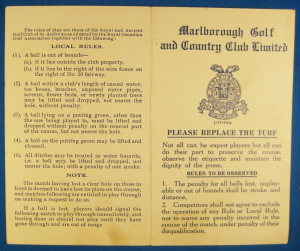
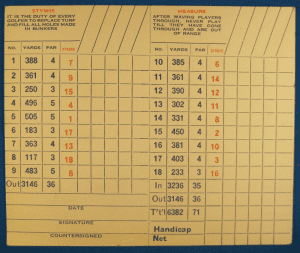
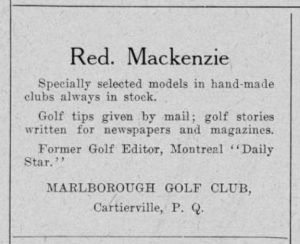
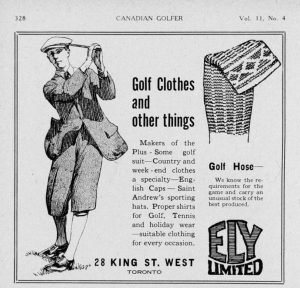
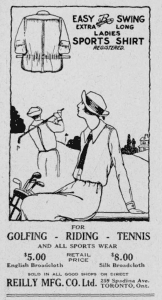
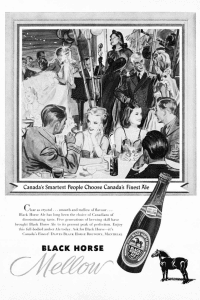
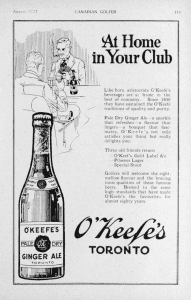
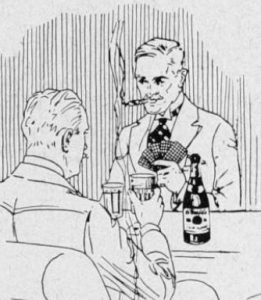
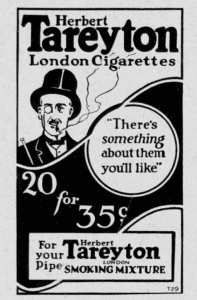

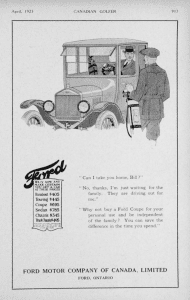
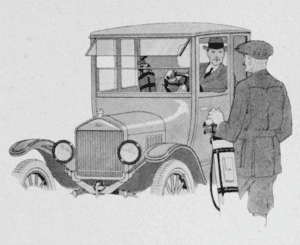
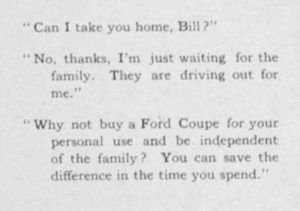
Good Stuff, Jaan.
I owe you thanks, Bob. Thank you for your feedback, first of all. As I worked on the post this morning, as well, I came to realize that I now understand the history of Saraguay much better than before. Much of what I know about Saraguay is based on conversations with you over the years.